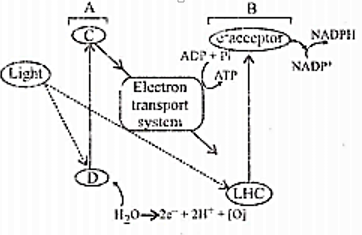 Multiple Choice Questions
Multiple Choice QuestionsPhotosynthesis in C4 plants is relatively less limited by atmospheric CO2 levels because
there is effective pumping of CO2 into bundle sheath cells
RuBisCO in C4 plants has higher affinity for CO2
six carbon acids are the primary initial CO2 fixation products
the primary fixation of CO2 is mediated via PEP carboxylase.
The chemiosmotic coupling hypothesis of oxidative phosphorylation proposes that adenosine triphosphate (ATP) is formed because
a proton gradient forms across the inner mitochondrial membrane
there is a change in the permeability of the inner mitochondrial membrane towards adenosine diphosphate (ADP).
high energy bonds are formed in mitochondrial proteins
ADP is pumped out of the matrix into the intermembrane space
Carbon dioxide is necessary for photosynthesis. The chemical used to remove this gas most effectively from entering a control apparatus is
calcium oxide
distilled water
potassium hydroxide solution
sodium carbonate.
Assertion: In light reaction of photosynthesis, light is required for the functioning of PS I and PS II, and production of NADPH and ATP.
Reason: Dark reaction does not occur in light.
If both assertion and reason are true and reason is the correct explanation of assertion.
If both assertion and reason are true but reason is not the correct explanation of assertion.
If assertion is true but reason is false.
If both assertion and reason are false.
Assertion : CAM plants lack structural compartmentation of leaf as found in C4 plants.
Reason : Stomata of CAM plants are open during the day.
If both assertion and reason are true and reason is the correct explanation of assertion
If both assertion and reason are true but reason is not the correct explanation of assertion
If assertion is true but reason is false
If both assertion and reason are false
C4 plants have better productivity because
C4 plants absorb more light
C4 plants absorb more CO2
C4 plants does not carry photorespiration
C4 plants have more amount of RuBisCO
Assertion: Photorespiration interferes with the successful functioning of Calvin cycle.
Reason: Photorespiration oxidises ribulose1,5 biphosphate which is an acceptor of CO2 in Calvin cycle.
If both assertion and reason are true and reason is the correct explanation of assertion.
If both assertion and reason are true but reason is not the correct explanation of assertion.
If assertion is true but reason is false.
If both assertion and reason are false.
Photorespiration shows formation of
sugar but not ATP
ATP but not sugar
both ATP and sugar
neither ATP nor sugar
D.
neither ATP nor sugar
Photorespiration is the light dependent process of oxygenation of ribulose biphosphate (RuBP) and release of carbon dioxide by the photosynthetic organs of a plant. Normally photosynthetic organs do the reverse in the light, i.e., uptake of CO2 and release of O2 At high temperature, RuBP carboxylase functions as oxygenase and instead of fixing carbon dioxide (C4 cycle), oxidises ribulose 1, 5-biphosphate to produce a 3-carbon phosphoglyceric acid and a 2-carbon phosphoglycolate. Photorespiration does not produce energy or reducing power. Rather, it consumes energy. Further, it undoes the work of photosynthesis. There is 25% loss of fixed CO2. Therefore, photorespiration is a highly wasteful process. This happens only in case of C4 plants. C4 plants have overcome the problem of photorespiration.

Which of the following is correctly labelled for the given figure
A: PS II; B : PS I; C :e- acceptor, D: LHC
A: LHC; B:e- acceptor; C: PS I; D: PS II
A: PS I; B:PS II; C:e- acceptor; D: LHC
A: e- acceptor; B : LHC; C: PS Il; D: PS I
Kranz anatomy is usually associated with
C3 plants
C4 plants
CAM plants
C3-C4intermediate plants.
